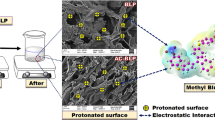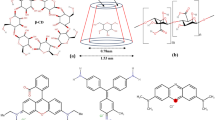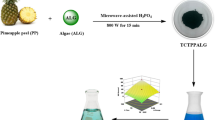Abstract
Due to the significant expansion of industrial activity, dye pollution of natural water systems has become a serious concern. The dyes are considered to be very undesirable pollutants because they are extremely visible, do not biodegrade, and are toxic in nature. Therefore, it has been decided to design an affordable, straightforward, efficient, and simple method for the removal of dyes from wastewater. The present investigation explored the adsorption characteristics of magnetized Artocarpus heterophyllus fruit peel (MAHFP) for the cationic methylene blue dye (MBD). The MAHFP adsorbent was characterized by VSM, SEM/EDAX, FTIR, TEM/SAED, BET, TGA, XRD, and point of zero charge. Batch studies were performed using various laboratory conditions: initial dye concentration, medium pH, adsorbent dosage, and temperature. The optimal conditions for adsorption resulted in a removal efficiency of 91.93%. Langmuir isotherms were well suited to the adsorption of MBD on MAHFP, and the adsorption capacity of 261.35 mg/g was determined for maximum monolayer coverage. The results were best explained by pseudo-second-order kinetics. Adsorption was raised to be thermodynamically feasible and supported by heat absorption and entropy increase. In the regeneration study, MAHFP was regenerated up to five times employing HCl as the most effective desorbing agent. The current adsorbent is an appealing choice for removing MBD from wastewater since it has an extremely high adsorption affinity for dye, is simple to separate, requires low-cost, and is reusable.







Similar content being viewed by others
References
Schwarzenbach, R.P.; Egli, T.; Hofstetter, T.B.; von Gunten, U.; Wehrli, B.: Global water pollution and human health. Annu. Rev. Environ. Resour. 35, 109–136 (2010). https://doi.org/10.1146/annurev-environ-100809-125342
Fu, F.; Wang, Q.: Removal of heavy metal ions from wastewaters: a review. J. Environ. Manag. 92, 407–418 (2011). https://doi.org/10.1016/j.jenvman.2010.11.011
Ahmad, T.; Rafatullah, M.; Ghazali, A.; Sulaiman, O.; Hashim, R.: Oil palm biomass-based adsorbents for the removal of water pollutants—a review. J. Environ. Sci. Health Part C 29, 177–222 (2011). https://doi.org/10.1080/10590501.2011.601847
Qamruzzaman; Nasar, A.: Treatment of acetamiprid insecticide from artificially contaminated water by colloidal manganese dioxide in the absence and presence of surfactants. RSC Adv. 4, 62844–62850 (2014). https://doi.org/10.1039/c4ra09685a
Kant, R.: Textile dyeing industry an environmental hazard. Nat. Sci. 04, 22–26 (2012). https://doi.org/10.4236/ns.2012.41004
Verma, A.K.; Dash, R.R.; Bhunia, P.: A review on chemical coagulation/flocculation technologies for removal of colour from textile wastewaters. J. Environ. Manag. 93, 154–168 (2012). https://doi.org/10.1016/j.jenvman.2011.09.012
Dutta, S.; Gupta, B.; Srivastava, S.K.; Gupta, A.K.: Recent advances on the removal of dyes from wastewater using various adsorbents: a critical review. Mater. Adv. 2, 4497–4531 (2021). https://doi.org/10.1039/D1MA00354B
Crini, G.: Non-conventional low-cost adsorbents for dye removal: a review. Bioresour. Technol. 97, 1061–1085 (2006). https://doi.org/10.1016/j.biortech.2005.05.001
Munagapati, V.S.; Kim, D.S.: Adsorption of anionic azo dye congo red from aqueous solution by cationic modified orange peel powder. J. Mol. Liq. 220, 540–548 (2016). https://doi.org/10.1016/j.molliq.2016.04.119
Lellis, B.; Fávaro-Polonio, C.Z.; Pamphile, J.A.; Polonio, J.C.: Effects of textile dyes on health and the environment and bioremediation potential of living organisms. Biotechnol. Res. Innov. 3, 275–290 (2019). https://doi.org/10.1016/j.biori.2019.09.001
Lee, J.W.; Choi, S.P.; Thiruvenkatachari, R.; Shim, W.G.; Moon, H.: Evaluation of the performance of adsorption and coagulation processes for the maximum removal of reactive dyes. Dye. Pigment. 69, 196–203 (2006). https://doi.org/10.1016/j.dyepig.2005.03.008
Butani, S.A.; Mane, S.J.: Coagulation/flocculation process for cationic, anionic dye removal using water treatment residuals—a review. Int. J. Sci. Technol. Manag. 6, 121–125 (2017)
Marin, N.M.; Pascu, L.F.; Demba, A.; Nita-Lazar, M.; Badea, I.A.; Aboul-Enein, H.Y.: Removal of the acid orange 10 by ion exchange and microbiological methods. Int. J. Environ. Sci. Technol. 16, 6357–6366 (2019). https://doi.org/10.1007/s13762-018-2164-2
Joseph, J.; Radhakrishnan, R.C.; Johnson, J.K.; Joy, S.P.; Thomas, J.: Ion-exchange mediated removal of cationic dye-stuffs from water using ammonium phosphomolybdate. Mater. Chem. Phys. 242, 122488 (2020). https://doi.org/10.1016/j.matchemphys.2019.122488
Al-Amshawee, S.; Yunus, M.Y.B.M.; Azoddein, A.A.M.; Hassell, D.G.; Dakhil, I.H.; Hasan, H.A.: Electrodialysis desalination for water and wastewater: a review. Chem. Eng. J. 380, 122231 (2020). https://doi.org/10.1016/j.cej.2019.122231
Greenlee, L.F.; Lawler, D.F.; Freeman, B.D.; Marrot, B.; Moulin, P.: Reverse osmosis desalination: water sources, technology, and today’s challenges. Water Res. 43, 2317–2348 (2009). https://doi.org/10.1016/j.watres.2009.03.010
Qasim, M.; Badrelzaman, M.; Darwish, N.N.; Darwish, N.A.; Hilal, N.: Reverse osmosis desalination: a state-of-the-art review. Desalination 459, 59–104 (2019). https://doi.org/10.1016/j.desal.2019.02.008
Muruganandham, M.; Amutha, R.; Repo, E.; Sillanpää, M.; Kusumoto, Y.; Abdulla-Al-Mamun, M.: Controlled mesoporous self-assembly of ZnS microsphere for photocatalytic degradation of Methyl Orange dye. J. Photochem. Photobiol. A Chem. 216, 133–141 (2010). https://doi.org/10.1016/j.jphotochem.2010.06.008
Hameed, B.H.; Mahmoud, D.K.; Ahmad, A.L.: Sorption of basic dye from aqueous solution by pomelo (Citrus grandis) peel in a batch system. Colloids Surf. A Physicochem. Eng. Asp. 316, 78–84 (2008). https://doi.org/10.1016/j.colsurfa.2007.08.033
Chakraborty, S.; Purkait, M.K.; DasGupta, S.; De, S.; Basu, J.K.: Nanofiltration of textile plant effluent for color removal and reduction in COD. Sep. Purif. Technol. 31, 141–151 (2003). https://doi.org/10.1016/S1383-5866(02)00177-6
Khamparia, S.; Jaspal, D.K.: Adsorption in combination with ozonation for the treatment of textile waste water: a critical review. Front. Environ. Sci. Eng. 11, 8 (2017). https://doi.org/10.1007/s11783-017-0899-5
Qamruzzaman; Nasar, A.: Kinetics of metribuzin degradation by colloidal manganese dioxide in absence and presence of surfactants. Chem. Pap. 68, 65–73 (2014). https://doi.org/10.2478/s11696-013-0424-7
Qamruzzaman; Nasar, A.: Degradation of acephate by colloidal manganese dioxide in the absence and presence of surfactants. Desalin. Water Treat. 55, 2155–2164 (2015). https://doi.org/10.1080/19443994.2014.937752
Aragaw, T.A.; Bogale, F.M.: Biomass-based adsorbents for removal of dyes from wastewater: a review. Front. Environ. Sci. (2021). https://doi.org/10.3389/fenvs.2021.764958
Soltani, A.; Faramarzi, M.; Mousavi Parsa, S.A.: A review on adsorbent parameters for removal of dye products from industrial wastewater. Water Qual. Res. J. 56, 181–193 (2021). https://doi.org/10.2166/wqrj.2021.023
Hossain, M.A.; Ngo, H.H.; Guo, W.S.; Setiadi, T.: Adsorption and desorption of copper(II) ions onto garden grass. Bioresour. Technol. 121, 386–395 (2012). https://doi.org/10.1016/j.biortech.2012.06.119
Tsai, W.T.; Yang, J.M.; Lai, C.W.; Cheng, Y.H.; Lin, C.C.; Yeh, C.W.: Characterization and adsorption properties of eggshells and eggshell membrane. Bioresour. Technol. 97, 488–493 (2006). https://doi.org/10.1016/j.biortech.2005.02.050
El-Azazy, M.; El-Shafie, A.S.; Issa, A.A.; Al-Sulaiti, M.; Al-Yafie, J.; Shomar, B.; Al-Saad, K.: Potato peels as an adsorbent for heavy metals from aqueous solutions: eco-structuring of a green adsorbent operating plackett-burman design. J. Chem. 2019, 1–14 (2019). https://doi.org/10.1155/2019/4926240
Ahmed, M.; Nasar, A.: Utilization of jackfruit peel as a low-cost adsorbent for the removal of methylene blue dye from synthetically polluted water. Curr. Anal. Chem. 17, 1016–1026 (2021). https://doi.org/10.2174/1573411016666200203153318
Yagub, M.T.; Sen, T.K.; Ang, H.M.: Equilibrium, kinetics, and thermodynamics of methylene blue adsorption by pine tree leaves. Water Air Soil Pollut. 223, 5267–5282 (2012). https://doi.org/10.1007/s11270-012-1277-3
Pavan, F.A.; Mazzocato, A.C.; Gushikem, Y.: Removal of methylene blue dye from aqueous solutions by adsorption using yellow passion fruit peel as adsorbent. Bioresour. Technol. 99, 3162–3165 (2008). https://doi.org/10.1016/j.biortech.2007.05.067
Ezeonuegbu, B.A.; Machido, D.A.; Whong, C.M.Z.; Japhet, W.S.; Alexiou, A.; Elazab, S.T.; Qusty, N.; Yaro, C.A.; Batiha, G.E.-S.: Agricultural waste of sugarcane bagasse as efficient adsorbent for lead and nickel removal from untreated wastewater: biosorption, equilibrium isotherms, kinetics and desorption studies. Biotechnol. Rep. 30, e00614 (2021). https://doi.org/10.1016/j.btre.2021.e00614
Çelebi, H.; Gök, G.; Gök, O.: Adsorption capability of brewed tea waste in waters containing toxic lead(II), cadmium(II), nickel(II), and zinc(II) heavy metal ions. Sci. Rep. 10, 17570 (2020). https://doi.org/10.1038/s41598-020-74553-4
Nasar, A.: Utilization of tea wastes for the removal of toxic dyes from polluted water—a review. Biomass Convers. Biorefinery 13, 1399–1415 (2023). https://doi.org/10.1007/s13399-020-01205-y
Kim, M.-S.; Kim, J.-G.: Adsorption characteristics of spent coffee grounds as an alternative adsorbent for cadmium in solution. Environments 7, 24 (2020). https://doi.org/10.3390/environments7040024
Anastopoulos, I.; Karamesouti, M.; Mitropoulos, A.C.; Kyzas, G.Z.: A review for coffee adsorbents. J. Mol. Liq. 229, 555–565 (2017). https://doi.org/10.1016/j.molliq.2016.12.096
Sartape, A.S.; Mandhare, A.M.; Jadhav, V.V.; Raut, P.D.; Anuse, M.A.; Kolekar, S.S.: Removal of malachite green dye from aqueous solution with adsorption technique using Limonia acidissima (wood apple) shell as low cost adsorbent. Arab. J. Chem. 10, S3229–S3238 (2017). https://doi.org/10.1016/j.arabjc.2013.12.019
Jagadeesh, S.L.; Reddy, B.S.; Swamy, G.S.K.; Gorbal, K.; Hegde, L.; Raghavan, G.S.V.: Chemical composition of jackfruit (Artocarpus heterophyllus Lam.) selections of Western Ghats of India. Food Chem. 102, 361–365 (2007). https://doi.org/10.1016/j.foodchem.2006.05.027
Mashkoor, F.; Nasar, A.: Magsorbents: potential candidates in wastewater treatment technology—a review on the removal of methylene blue dye. J. Magn. Magn. Mater. 500, 166408 (2020). https://doi.org/10.1016/j.jmmm.2020.166408
Medhat, A.; El-Maghrabi, H.H.; Abdelghany, A.; Abdel Menem, N.M.; Raynaud, P.; Moustafa, Y.M.; Elsayed, M.A.; Nada, A.A.: Efficiently activated carbons from corn cob for methylene blue adsorption. Appl. Surf. Sci. Adv. 3, 100037 (2021). https://doi.org/10.1016/j.apsadv.2020.100037
Ahmed, M.; Mashkoor, F.; Nasar, A.: Development, characterization, and utilization of magnetized orange peel waste as a novel adsorbent for the confiscation of crystal violet dye from aqueous solution. Groundw. Sustain. Dev. 10, 100322 (2020). https://doi.org/10.1016/j.gsd.2019.100322
Lawagon, C.P.; Amon, R.E.C.: Magnetic rice husk ash “cleanser” as efficient methylene blue adsorbent. Environ. Eng. Res. 25, 685–692 (2019). https://doi.org/10.4491/eer.2019.287
Xia, Y.; Yao, Q.; Zhang, W.; Zhang, Y.; Zhao, M.: Comparative adsorption of methylene blue by magnetic baker’s yeast and EDTAD-modified magnetic baker’s yeast: equilibrium and kinetic study. Arab. J. Chem. 12, 2448–2456 (2019). https://doi.org/10.1016/j.arabjc.2015.03.010
Cheng, S.; Zhang, L.; Ma, A.; Xia, H.; Peng, J.; Li, C.; Shu, J.: Comparison of activated carbon and iron/cerium modified activated carbon to remove methylene blue from wastewater. J. Environ. Sci. 65, 92–102 (2018). https://doi.org/10.1016/j.jes.2016.12.027
Li, C.; Wang, X.; Meng, D.; Zhou, L.: Facile synthesis of low-cost magnetic biosorbent from peach gum polysaccharide for selective and efficient removal of cationic dyes. Int. J. Biol. Macromol. 107, 1871–1878 (2018). https://doi.org/10.1016/j.ijbiomac.2017.10.058
Zhu, H.-Y.; Fu, Y.-Q.; Jiang, R.; Jiang, J.-H.; Xiao, L.; Zeng, G.-M.; Zhao, S.-L.; Wang, Y.: Adsorption removal of congo red onto magnetic cellulose/Fe3O4/activated carbon composite: equilibrium, kinetic and thermodynamic studies. Chem. Eng. J. 173, 494–502 (2011). https://doi.org/10.1016/j.cej.2011.08.020
Ponnusami, V.; Vikram, S.; Srivastava, S.N.: Guava (Psidium guajava) leaf powder: novel adsorbent for removal of methylene blue from aqueous solutions. J. Hazard. Mater. 152, 276–286 (2008). https://doi.org/10.1016/j.jhazmat.2007.06.107
Mashkoor, F.; Nasar, A.: Preparation, characterization and adsorption studies of the chemically modified Luffa aegyptica peel as a potential adsorbent for the removal of malachite green from aqueous solution. J. Mol. Liq. 274, 315–327 (2019). https://doi.org/10.1016/j.molliq.2018.10.119
Feng, Y.; Gong, J.-L.; Zeng, G.-M.; Niu, Q.-Y.; Zhang, H.-Y.; Niu, C.-G.; Deng, J.-H.; Yan, M.: Adsorption of Cd(II) and Zn(II) from aqueous solutions using magnetic hydroxyapatite nanoparticles as adsorbents. Chem. Eng. J. 162, 487–494 (2010). https://doi.org/10.1016/j.cej.2010.05.049
Gupta, V.K.; Nayak, A.: Cadmium removal and recovery from aqueous solutions by novel adsorbents prepared from orange peel and Fe2O3 nanoparticles. Chem. Eng. J. 180, 81–90 (2012). https://doi.org/10.1016/j.cej.2011.11.006
Ali, I.; Peng, C.; Ye, T.; Naz, I.: Sorption of cationic malachite green dye on phytogenic magnetic nanoparticles functionalized by 3-marcaptopropanic acid. RSC Adv. 8, 8878–8897 (2018). https://doi.org/10.1039/C8RA00245B
Mashkoor, F.; Nasar, A.; Asiri, A.M.: Exploring the reusability of synthetically contaminated wastewater containing crystal violet dye using tectona grandis sawdust as a very low-cost adsorbent. Sci. Rep. 8, 8314 (2018). https://doi.org/10.1038/s41598-018-26655-3
Kataria, N.; Garg, V.K.: Application of EDTA modified Fe3O4/sawdust carbon nanocomposites to ameliorate methylene blue and brilliant green dye laden water. Environ. Res. 172, 43–54 (2019). https://doi.org/10.1016/j.envres.2019.02.002
Alizadeh, N.; Shariati, S.; Besharati, N.: Adsorption of crystal violet and methylene blue on azolla and fig leaves modified with magnetite iron oxide nanoparticles. Int. J. Environ. Res. 11, 197–206 (2017). https://doi.org/10.1007/s41742-017-0019-1
El Messaoudi, N.; El Khomri, M.; Dbik, A.; Bentahar, S.; Lacherai, A.; Bakiz, B.: Biosorption of Congo red in a fixed-bed column from aqueous solution using jujube shell: experimental and mathematical modeling. J. Environ. Chem. Eng. 4, 3848–3855 (2016). https://doi.org/10.1016/j.jece.2016.08.027
Chizari Fard, G.; Mirjalili, M.; Najafi, F.: Hydroxylated α-Fe2O3 nanofiber: optimization of synthesis conditions, anionic dyes adsorption kinetic, isotherm and error analysis. J. Taiwan Inst. Chem. Eng. 70, 188–199 (2017). https://doi.org/10.1016/j.jtice.2016.10.045
Foo, K.Y.; Hameed, B.H.: Insights into the modeling of adsorption isotherm systems. Chem. Eng. J. 156, 2–10 (2010). https://doi.org/10.1016/j.cej.2009.09.013
Singh, D.K.; Mohan, S.; Kumar, V.; Hasan, S.H.: Kinetic, isotherm and thermodynamic studies of adsorption behaviour of CNT/CuO nanocomposite for the removal of As(III) and As(V) from water. RSC Adv. 6, 1218–1230 (2016). https://doi.org/10.1039/C5RA20601D
Zhou, C.H.; Zhao, L.Z.; Wang, A.Q.; Chen, T.H.; He, H.P.: Current fundamental and applied research into clay minerals in China. Appl. Clay Sci. 119, 3–7 (2016). https://doi.org/10.1016/j.clay.2015.07.043
Ai, L.; Zhou, Y.; Jiang, J.: Removal of methylene blue from aqueous solution by montmorillonite/CoFe2O4 composite with magnetic separation performance. Desalination 266, 72–77 (2011). https://doi.org/10.1016/j.desal.2010.08.004
Zargar, B.; Parham, H.; Rezazade, M.: Fast removal and recovery of methylene blue by activated carbon modified with magnetic iron oxide nanoparticles. J. Chin. Chem. Soc. 58, 694–699 (2011). https://doi.org/10.1002/jccs.201190108
Yan, H.; Li, H.; Yang, H.; Li, A.; Cheng, R.: Removal of various cationic dyes from aqueous solutions using a kind of fully biodegradable magnetic composite microsphere. Chem. Eng. J. 223, 402–411 (2013). https://doi.org/10.1016/j.cej.2013.02.113
Sekhavat Pour, Z.; Ghaemy, M.: Removal of dyes and heavy metal ions from water by magnetic hydrogel beads based on poly(vinyl alcohol)/carboxymethyl starch-g-poly(vinyl imidazole). RSC Adv. 5, 64106–64118 (2015). https://doi.org/10.1039/C5RA08025H
Tural, B.; Ertaş, E.; Enez, B.; Fincan, S.A.; Tural, S.: Preparation and characterization of a novel magnetic biosorbent functionalized with biomass of Bacillus subtilis : kinetic and isotherm studies of biosorption processes in the removal of Methylene Blue. J. Environ. Chem. Eng. 5, 4795–4802 (2017). https://doi.org/10.1016/j.jece.2017.09.019
Othman, N.H.; Alias, N.H.; Shahruddin, M.Z.; Abu Bakar, N.F.; Nik Him, N.R.; Lau, W.J.: Adsorption kinetics of methylene blue dyes onto magnetic graphene oxide. J. Environ. Chem. Eng. 6, 2803–2811 (2018). https://doi.org/10.1016/j.jece.2018.04.024
Shakoor, S.; Nasar, A.: Adsorptive decontamination of synthetic wastewater containing crystal violet dye by employing Terminalia arjuna sawdust waste. Groundw. Sustain. Dev. 7, 30–38 (2018). https://doi.org/10.1016/j.gsd.2018.03.004
Leng, L.; Yuan, X.; Zeng, G.; Shao, J.; Chen, X.; Wu, Z.; Wang, H.; Peng, X.: Surface characterization of rice husk bio-char produced by liquefaction and application for cationic dye (Malachite green) adsorption. Fuel 155, 77–85 (2015). https://doi.org/10.1016/j.fuel.2015.04.019
Wahab, M.A.; Jellali, S.; Jedidi, N.: Ammonium biosorption onto sawdust: FTIR analysis, kinetics and adsorption isotherms modeling. Bioresour. Technol. 101, 5070–5075 (2010). https://doi.org/10.1016/j.biortech.2010.01.121
Acknowledgements
The authors thank the Chairperson of the Department of Applied Chemistry, Faculty of Engineering and Technology, AMU, for extending laboratory facilities.
Author information
Authors and Affiliations
Contributions
MA conducted the experiments. AN managed and supervised the work. MA and AN interpreted and analyzed the experimental data. AN assisted MA in manuscript writing. All the authors discussed the manuscript and decided to submit the manuscript.
Corresponding author
Supplementary Information
Below is the link to the electronic supplementary material.
Rights and permissions
Springer Nature or its licensor (e.g. a society or other partner) holds exclusive rights to this article under a publishing agreement with the author(s) or other rightsholder(s); author self-archiving of the accepted manuscript version of this article is solely governed by the terms of such publishing agreement and applicable law.
About this article
Cite this article
Ahmed, M., Nasar, A. Decolorization of Methylene Blue Solution by Employing Magnetized Artocarpus heterophyllus Fruit Peel as a Novel Adsorbent. Arab J Sci Eng 48, 7647–7659 (2023). https://doi.org/10.1007/s13369-023-07673-4
Received:
Accepted:
Published:
Issue Date:
DOI: https://doi.org/10.1007/s13369-023-07673-4




